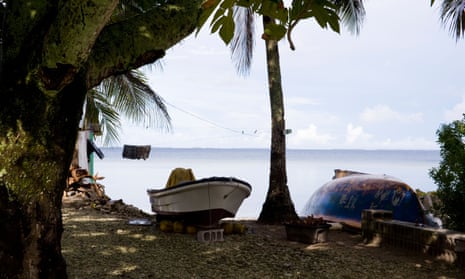Barack Obama has declared the severe drought in the Marshall Islands a disaster, opening the way for emergency US funding for the Pacific island nation.
The disaster declaration, which follows a request from Marshallese president Hilda Heine on 1 April, will allow Fema to provide emergency relief to the archipelago, which is suffering one of its worst-ever droughts. Fema is able to provide federal assistance to overseas territories such as the Virgin Islands, Puerto Rico, American Samoa and the Marshall Islands, as well as US states.
Heine declared a state of emergency in February after the Marshall Islands, a collection of atolls south-west of Hawaii, received just a quarter of its usual rainfall during the November to February period.
Water is being carefully distributed, with residents in the capital Majuro given an allocation once a week for a four-hour period. “We’re receiving complaints from the public that they’re out of water,” said Majuro mayor Ladie Jack as the emergency declaration was made.
The low-lying Marshall Islands is extremely reliant on consistent rainfall for its water supply, given there are few freshwater reservoirs or sources of groundwater. The strong El Niño climate event has fueled the drought, with Micronesia, Palau, Fiji and Papua New Guinea also affected to varying degrees.
The National Oceanic and Atmospheric Administration has warned “severe or extreme” drought conditions are set to persist, with just light rainfall expected in the coming months.
The US provided $5.5m drought relief to the Marshall Islands in 2013, following a dry spell that forced people to drink from coconuts and eat unripe breadfruit. Water catchments became clogged with dirt and salt, with the staple diet of fish becoming scarce as fishermen were unable to travel out under the hot sun for long periods without water.
The 50,000 people who live in the Marshall Islands are able to move to the US and work without a visa following an agreement made between the two countries. The US conducted nuclear testing at Bikini Atoll, part of the island network, in the 1940s and 1950s, forcing local people to relocate.
Climate change is a looming threat to the Marshall Islands. The low-lying atolls risk being swamped by rising sea levels, which could threaten key infrastructure and ruin drinking water supplies through salt intrusion.
The Marshall Islands were one of the most vocal nations calling for a 1.5C limit to the global temperature increase at the Paris climate talks last year, warning that the nation would be in mortal danger if warming hit 2C above pre-industrial times.

Comments (…)
Sign in or create your Guardian account to join the discussion